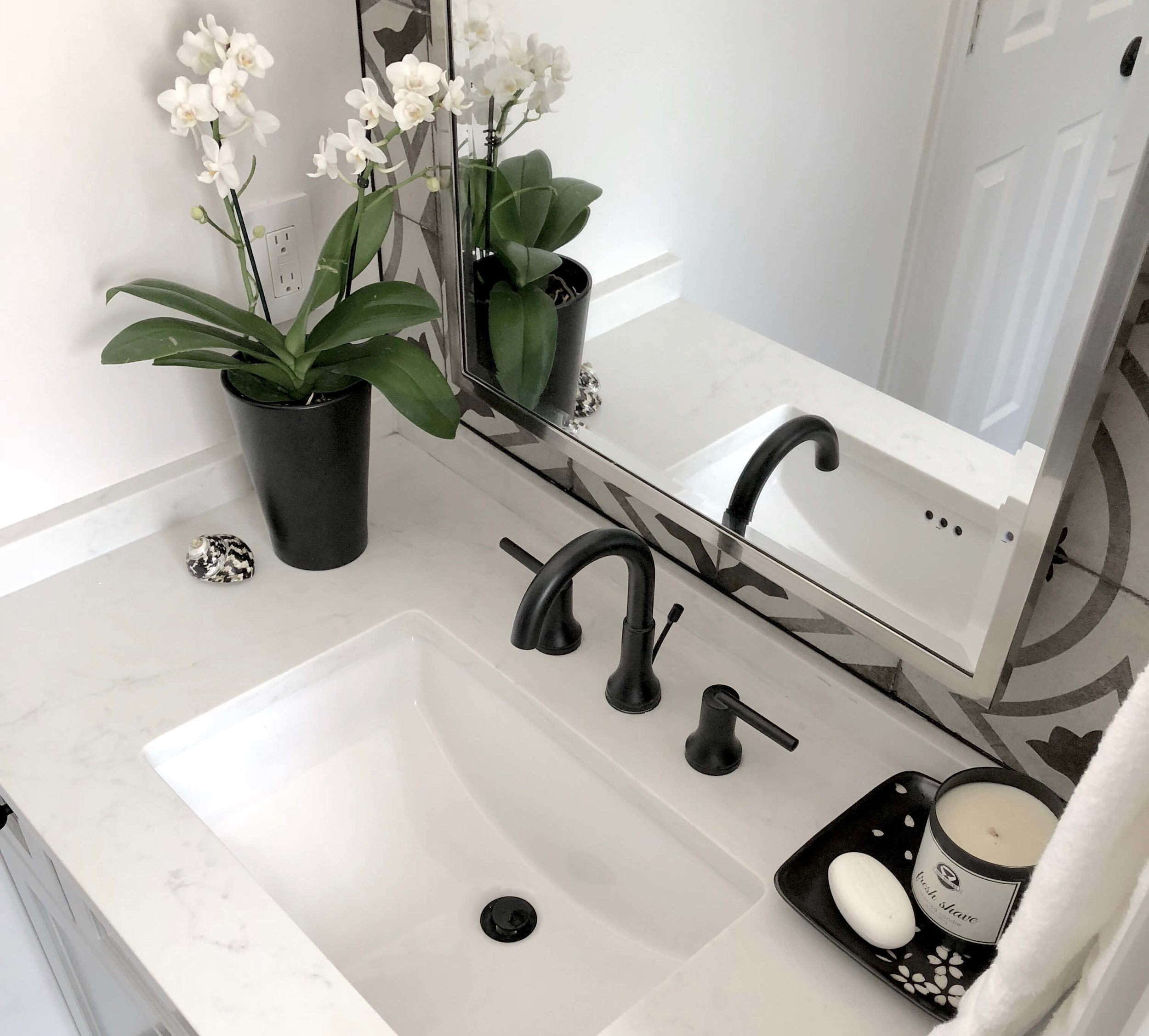Black Faucet Bathroom Styles: Black Faucet Bathroom Ideas
Black faucets are a versatile design element that can elevate the aesthetic of any bathroom. They add a touch of sophistication and can be incorporated into a variety of bathroom styles, from minimalist to industrial to contemporary. Here are some bathroom styles that can be beautifully enhanced with a black faucet.
Minimalist Bathroom with Black Faucet
A minimalist bathroom emphasizes clean lines, open spaces, and natural materials. Black faucets complement this aesthetic by adding a touch of modern elegance.
- Color Palette: Stick to a neutral color palette, such as white, gray, and beige, with accents of black.
- Materials: Incorporate natural materials like wood, stone, and ceramic.
- Fixtures: Choose sleek, minimalist fixtures with clean lines.
- Lighting: Opt for soft, ambient lighting.
Industrial Bathroom with Black Faucet
An industrial bathroom embraces exposed brick, metal accents, and reclaimed wood. Black faucets fit seamlessly into this style, adding a touch of ruggedness and sophistication.
- Color Palette: Use a dark color palette, such as gray, black, and brown.
- Materials: Incorporate exposed brick, metal accents, and reclaimed wood.
- Fixtures: Choose industrial-style fixtures with exposed pipes and metal accents.
- Lighting: Use industrial-style lighting, such as pendant lights or exposed bulb fixtures.
Contemporary Bathroom with Black Faucet, Black faucet bathroom ideas
A contemporary bathroom emphasizes sleek lines, bold geometric shapes, and modern fixtures. Black faucets can enhance this style by adding a touch of drama and sophistication.
- Color Palette: Use a bold color palette, such as black, white, and gray, with accents of bright colors.
- Materials: Incorporate modern materials, such as glass, metal, and acrylic.
- Fixtures: Choose sleek, modern fixtures with geometric shapes.
- Lighting: Use modern lighting, such as track lighting or pendant lights.
Black Faucet Material Considerations
Choosing the right material for your black faucet is crucial, as it impacts its durability, maintenance, and overall aesthetic appeal. While black finishes are popular, the underlying material significantly influences these aspects. Let’s explore the most common black faucet materials and their respective pros and cons.
Black Faucet Material Comparison
The durability, maintenance, and aesthetic appeal of black faucets vary significantly depending on the material used. Here’s a breakdown of the most common materials:
- Stainless Steel: Stainless steel is known for its durability and resistance to corrosion. It’s also relatively easy to clean and maintain, making it a popular choice for high-traffic bathrooms. The black finish on stainless steel is typically achieved through a PVD (Physical Vapor Deposition) coating, which adds a layer of protection and enhances its scratch resistance. However, stainless steel can be prone to fingerprints and water spots, especially in areas with hard water. It’s essential to regularly clean and polish stainless steel faucets to maintain their shine.
- Brass: Brass is another durable and corrosion-resistant material. It’s known for its classic elegance and can be polished to a high shine. Brass is often used in high-end faucets, and its black finish can be achieved through various methods, including electroplating, powder coating, and PVD coating. However, brass can be more expensive than stainless steel and requires more maintenance. It can also tarnish over time, especially in areas with high humidity or exposure to chemicals.
- Ceramic: Ceramic is a durable and aesthetically pleasing material that is often used in bathroom fixtures. It’s known for its smooth surface and resistance to scratches and stains. Ceramic faucets are typically finished with a black glaze, which adds a sleek and modern look. However, ceramic can be more fragile than other materials and may chip or crack if mishandled. It’s also important to note that ceramic faucets may not be as resistant to hard water stains as other materials.
Black Faucets in High-Traffic Bathrooms
High-traffic bathrooms present unique challenges for black faucets. Water hardness, cleaning frequency, and potential for wear and tear are all important factors to consider.
- Water Hardness: Hard water contains high levels of minerals like calcium and magnesium, which can leave behind unsightly stains on faucets. While all materials can be affected by hard water, stainless steel and brass are generally more resistant to mineral buildup than ceramic. Regular cleaning with a mild cleaner and a soft cloth is crucial to prevent mineral deposits from accumulating.
- Cleaning Requirements: Black faucets require regular cleaning to maintain their shine and prevent the buildup of dirt, grime, and water spots. Using a non-abrasive cleaner and a soft cloth is recommended to avoid scratching the finish. It’s also important to avoid using harsh chemicals or abrasive cleaning tools that can damage the faucet’s surface.
- Wear and Tear: High-traffic bathrooms see more use, which can lead to increased wear and tear on faucets. Stainless steel and brass are generally more durable than ceramic and can withstand the rigors of frequent use. However, it’s important to choose a high-quality faucet with a robust construction and a durable finish to ensure its longevity.
Choosing the Right Black Faucet Material
Selecting the right black faucet material depends on individual bathroom needs and preferences. Consider the following factors:
- Durability: For high-traffic bathrooms, stainless steel and brass offer greater durability and resistance to wear and tear. Ceramic is a suitable option for less demanding settings.
- Maintenance: Stainless steel and brass require regular cleaning to maintain their shine, while ceramic is relatively low-maintenance. Consider your willingness to dedicate time to cleaning your faucet when making your decision.
- Aesthetic Appeal: Each material offers a unique aesthetic appeal. Stainless steel provides a modern and sleek look, brass exudes a classic elegance, and ceramic offers a smooth and sophisticated finish.
- Budget: Brass faucets are generally more expensive than stainless steel and ceramic. Consider your budget and prioritize the features that are most important to you.
- Water Hardness: If you have hard water, stainless steel and brass are more resistant to mineral buildup than ceramic. Consider investing in a water softener if you’re concerned about hard water stains.

